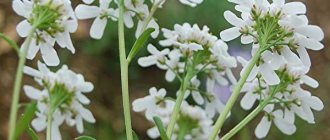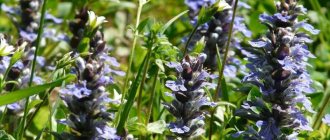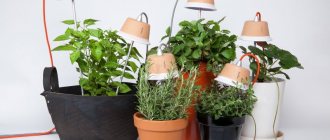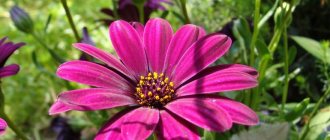Author: Elena N. https://floristics.info/ru/index.php?option=com_contact&view=contact&id=19 Category: Garden plants Published: February 04, 2019Last edits: January 20, 2021
- Growing on a windowsill
- Hybrid coleus (Coleus x hybridus)
Coleus, with its bright, variegated leaves, resembles both croton and begonia. This is a charming and not at all capricious plant that requires minimal care. Some may think that coleus is simple, but this is a misleading impression: the plant has a strong character and powerful energy potential. Interesting fact: on the surface of coleus leaves there are tubercles that work like lenses: by reflecting light, they make the color of the leaf plates brighter and more saturated.
You can learn from our article how to:
- grow coleus from seeds;
- care for the plant in the garden and at home;
- propagate coleus and protect it from diseases and pests.
Planting and caring for coleus
- Flowering: decorative deciduous plant.
- Planting: sowing seedlings - at the end of March, planting in the ground - from the second half of May.
- Lighting: bright sunlight until noon, then partial shade.
- Temperature: in summer – 18-20 ˚C, in winter – not lower than 12 ˚C.
- Watering: abundant and frequent.
- Air humidity: high, frequent spraying is necessary, especially in hot weather.
- Feeding: in spring and summer – once a week, in winter – once a month with complex mineral fertilizer.
- Pinching: during the period of active growth - regular.
- Pruning: after the dormant period before the start of the growing season.
- Dormant period: winter.
- Replanting: once every 3-4 years.
- Reproduction: seeds, cuttings.
- Pests: aphids, whiteflies, mealybugs and spider mites.
- Diseases: root and stem rot.
Read more about growing coleus below.
flowers (lat. Coleus) belong to the genus of the Lamiaceae or Lamiaceae family, numbering about 150 species. The name of the plant is derived from the Greek word “kleos”, meaning “case”. The homeland of the coleus plant is the tropical forests of Asia and Africa. Among hobby gardeners, the coleus flower is known as the "poor man's croton" because its variegated leaves resemble croton foliage, only they look simpler, and the "garbage plant" - well, that's because many of them have not seen the new varieties of coleus that allow it to compete today not only with croton, but also with other expensive popular plants. The main advantage of coleus, in addition to its variegated beauty, is its ease of care.
Disease and pest control
Most often, coleus is attacked by spider mites, aphids and whiteflies. They are controlled with insecticides. It is advisable to use biological products: Actofit, Bitoxibacillin, etc.
Coleus Blume is a fairly resistant plant, but if not properly cared for it can get sick. So, when the plant is flooded, rot develops, lack of pruning leads to bare stems, and lack of lighting negatively affects the condition of the leaves: they wither, turn yellow and fall off. To prevent this, carefully follow the rules for growing coleus.
Botanical description
Coleus stems are ribbed, tetrahedral, woody at the base. The leaves are pubescent, heart-shaped, opposite, jagged, sometimes small, but in some species they reach a length of 15 cm. The stems and leaves of natural plant species resemble nettles, which is why coleus is popularly nicknamed “nettle”. The color of the leaves is all possible combinations of green, burgundy, yellow, and red. Small blue or purple flowers are collected in spike-shaped inflorescences.
- Features of caring for the Decembrist
The flowering of decorative-leaved coleus does not cause any particular interest among gardeners - there is nothing remarkable in its flowers. These types of coleus are grown for their amazing leaves, although there are also beautifully flowering species and varieties of coleus.
Care during flowering
Flowering is always an energy-consuming process. And since the flowering of coleus does not represent any decorative effect, it is necessary to preserve the plant’s reserves of energy for the growth of greenery rather than storing seeds.
The exotic will bloom in long spikelets with small lilac flowers.
From the very beginning of the release of a flower spike, it should be removed. The cut area does not need to be processed.
Growing coleus in the garden
Sowing seeds
The coleus plant is popular not only because it is beautiful, but also because it is easy to care for. And most importantly, the houseplant coleus can be grown in gardens with no less success. Coleus reproduces well by seed, especially since excellent English and Dutch variety mixtures can easily be found on sale today. It is best to sow coleus at the end of March. You can do this at other times of the year, but then you will have to provide additional artificial lighting for the seedlings in winter or autumn.
You will need fertile but light soil; it is best to use a flat box as a container. Coleus seeds are laid out on the surface of the soil, not in a heap, sprayed with a spray bottle, without covering them, lightly “salted” with sand, covered with glass and placed in a warm, dark place, subsequently maintaining the soil in the greenhouse in a slightly damp state.
The germination rate of purchased seeds is very high, and you can expect that every seed will germinate. This will happen faster than you expect - already on the seventh to tenth day, and as soon as the first shoots appear, remove the glass and move the greenhouse to a bright eastern or western window, protecting the sprouts from direct sunlight. The temperature should now be 17-19 ºC.
In the photo: Coleus / Coleus Honey Crisp
Growing seedlings
At the age of 3-4 weeks, when the seedlings have the first pair of true leaves, they need to be transplanted into special cassettes so that they can develop a strong root system that can not be injured when transplanted into the ground. And when the young coleus are 5-6 weeks old, transplant each into a four-hundred-gram glass and pinch to stimulate tillering.
Planting coleus
Coleus are planted in garden soil only after the final onset of warm days. Choose a brightly lit area for them, but slightly shaded at midday and protected from the wind, dig holes, add fertile water- and breathable substrate into them, and plant coleus bushes from cups in the holes. Planting coleus does not require any special knowledge or skills.
- Epipremnum at home: care and types
If you grow it as an annual, even more so. And even if you plan to make a perennial out of it, then, firstly, you are unlikely to succeed - in two or three years you will still have to grow a new coleus from seeds or cuttings, and secondly, you will have to winter it dig it up and bring it into the house so that it can be planted in the ground again in the spring. Therefore, just plant coleus bushes at a short distance from each other and do not forget to water them after planting.
In the photo: Beautiful coleus leaves
Coleus care
Caring for coleus primarily involves abundant watering, especially in dry summer conditions. It is advisable to water with settled water, for which it is a good idea to have a barrel or tub in the garden in which tap water will settle or rainwater will accumulate. Loosen the soil after watering and remove weeds. Two or three times a summer, lightly trim your handsome man to make him bushier.
In the photo: Coleus in open ground
During the period of active growth, fertilizing should be done weekly with fertilizers with a high nitrogen content in order to stimulate leaf growth and not provoke early flowering. When flowering does occur, immediately remove the flower stalks so that they do not take away the strength of the coleus. That's all the wisdom. As you can see, growing coleus in the garden is not difficult.
Landing
Coleus needs a large dose of sun, which will make its leaves large and intensely colored.
Soil for coleus is needed with the following characteristics:
- average or fertile;
- well drained;
- moist but not waterlogged;
- acidic or neutral (pH 5-7).
When planting in open ground, the area must be dug up before planting, weeds must be selected, and if necessary, well-rotted compost or peat must be added for digging.
When planting in a pot, you can use universal soil for balcony flowers.
Coleus seedlings can be planted outside in open ground after May 15-20, when the last frost has passed. Plants are planted at a distance of 15 × 25 cm or one seedling per pot with a diameter of 12-13 cm.
Coleus at home
Growing on a windowsill
Indoor coleus, like garden coleus, is propagated by seeds and cuttings. Propagation of indoor coleus by seeds occurs in the same way as garden ones: the seeds are sown, and when shoots appear, they are planted into cassettes, and during the second planting the seedling is planted in a permanent pot. Everything is simple, and almost the same as with seed propagation of garden coleus. And now we will tell you how to grow coleus from cuttings.
In the photo: Coleus / Coleus Henna
Growing coleus from cuttings
When you cut the coleus, you are left with cuttings that you can use for cuttings. The stalk should be about 10 cm long. You need to remove the leaves from its lower part and stick it into damp soil or sand, cover it with polyethylene or a plastic bottle and keep it in the shade at a temperature of 18-20 ºC. The roots will appear in 8-10 days, and you can immediately transplant the cutting to a permanent place. This type of propagation is as simple as it is reliable.
Home care
There are no difficulties in this matter either: abundant watering with settled soft water at room temperature, especially in the spring and summer, is the most important point. Indoor coleus also needs to be fertilized weekly in spring and summer with complex fertilizer at half the dose specified by the manufacturer. In winter, fertilize coleus once a month.
In the photo: Coleus / Coleus Magilla Perilla
In the warm season, regular spraying of the plant is desirable, but not in the sun, but in the shade, and in winter, in a heated room, it is better to maintain air humidity in another way - keeping a pot of coleus on a tray with wet expanded clay. Be sure to remove the buds that appear if your coleus is not an ornamental flowering plant, so that the development of flowers does not take away the strength of the plant.
- Areca at home: care and types
During the period of active growth, coleus will have to be pinched more than once, stimulating branching, and after rest, before the new season, you need to cut off all shoots at a height of 5-7 cm in order to rejuvenate the plant. Experienced flower growers, just in case, plant cuttings obtained during pruning for rooting - in case last year’s coleus does not live up to expectations and still loses its decorative effect.
In the photo: Growing coleus in a flower bed
Diseases and their treatment
If you pinch or trim a young plant at the wrong time, its shoots can become very elongated. The same thing happens if your coleus is old or if the young plant is dark. If the light is too bright, the color of the leaves becomes pale and discolored. If there is insufficient watering, the plant loses its leaves; if it is over-watered, the leaves will also fall off.
Among the pests that are dangerous to coleus are aphids, spider mites and whiteflies. Aphids feed on plant sap, causing damaged leaves to turn yellow and shrink, and are carriers of diseases. It’s easy to combat: you need to treat the above-ground parts of indoor coleus with a soap solution, and if some of the pests survive, then the treatment needs to be repeated after a week. Before manipulating, do not forget to cover the soil in the pot with film so that soap does not get into it.
With garden coleus, such a “detailed” method is too labor-intensive, so you will have to use insecticides. Actellik and Fitoverm have proven themselves to be good in the fight against aphids. You cannot use soap to remove ticks, so we recommend Oberon, Apollo, Agravertin or Akarin. Whiteflies can be destroyed with the same drugs as aphids: Actellik, Aktara, Oberon, etc.
In the photo: Coleus tricolor / Coleus Tricolor
But the use of insecticides does not add health to the plants, so as a preventive measure, follow simple rules for caring for coleus, and such troubles as diseases and pests will bypass you.
How to collect coleus seeds
Coleus is grown from seeds using not only purchased, but also personally collected material. The harvesting of crop grains for subsequent planting is carried out according to the following algorithm:
- During the decorative period, the healthiest and strongest bushes are chosen.
- Large buds are tied with folded gauze, securing peculiar bags on the peduncles.
- Wait until the flowers dry completely.
- Cut off the stems along with the tied buds.
- At home, unfold gauze over a sheet of paper.
- Sprinkle out the seeds.
After harvesting, the planting material must be dried in a warm place with good ventilation. Then the grains are poured into a paper envelope, the name of the variety and the date of collection are signed. Seeds should be stored in a dark and dry place until planting.
Hybrid varieties of coleus are not grown from collected seeds, since the seedlings do not retain unique characteristics
When collecting material for planting at home, it is important not to miss the optimal timing. Ripe seeds spill out very easily from fading buds, and it is impossible to pick them up from the ground after this - they are very small.
Coleus in winter
As already mentioned, garden coleus is most often grown as an annual. If you are sorry to part with it, dig up a bush, replant it in a pot, bring it into the house and care for it like a houseplant: gradually reduce watering towards winter, and fertilize once a month. You should also care for indoor coleus. In winter, in addition to reducing watering, the temperature of the coleus should also be reduced to 8-15 ºC.
In the photo: Coleus flower / Coleus Beaute de Lyon
Reproduction methods
The coleus plant can be propagated by two methods: seeds and cuttings. For the first method, you should use containers whose depth is shallow. They are filled with a light type of substrate with a large amount of nutrients. The seeds are distributed over the surface of the soil, sprinkled with a layer of sand on top. After this, the soil is moistened with a spray bottle and the container is covered with a cloth made of transparent material. The windowsill on which the seeds will germinate should be warm and well lit.
For successful germination of planting material, it is recommended to maintain a temperature of 20-25 ° C, perform systematic ventilation and remove condensation under cover. Under suitable conditions, the seeds will sprout 14 days after they are sown. With the onset of this period, the shelter must be removed. If possible, it is better to move the containers to the windowsill on the east or west side for better development.
For propagation by cuttings, flower growers often use shoots that remain after pruning. But its length should not be less than 10 centimeters. The bottom of the cutting should be cleared of leaves and then planted in moist soil. The containers are covered with a polyethylene bag or a plastic cup. In order for the plant to develop healthy roots, it needs to be provided with shade and a temperature of 20°C. After a couple of weeks, the sprouts are ready to be transplanted to a long-term location.
Some gardeners, in order to improve the process of formation of the root system, immerse the cuttings in water diluted with a stimulating drug. Once the roots appear, the seedlings are transplanted into the ground.
Types and varieties
Hybrid coleus (Coleus x hybridus)
In indoor floriculture, as a rule, hybrid coleus - the plant is not very large and completely unpretentious. The height of hybrid coleus reaches one meter, the stem has a square cross-section. The leaves are elongated-oval with serrated edges. Depending on whether the plant is in the shade or in the sun, the color of the leaves may be green or burgundy, respectively.
Pictured: Purple coleus
Coleus rehneltianus
Coleus Renelta, originally from Sri Lanka, is grown as an ornamental hanging plant The leaves of this species are opposite, on long petioles, broadly heart-shaped with wavy edges, decorated with multi-colored veins - yellow, purple, brown, red...
In the photo: Coleus bush
Coleus blumeii
But the most popular among gardeners is Coleus Blume and its many varieties. The homeland of Coleus Blume is Southeast Asia. It is a subshrub with woody shoots up to 80 cm high at the base. The best varieties: Black dragon - brown-purple leaves ribbed along the edges with red veins; hybrids of the Wizzard series - coleus Wizzard Golden with yellow-light green leaves, Wizzard Evening Dawn with fiery red leaves and a narrow greenish border, Wizzard Jade with a wide green border along white leaves.
Among the huge variety of coleus varieties, you are sure to find several species with which you will be happy to decorate your garden and your home.
Use in landscape design
Spectacular combinations of coleus come out with plants of a single color. These can be lily, sage, gypsophila, cineraria, daylily. Gardeners and landscape designers create carpet beds and arabesques from this shrub. By planting varieties of different colors, you can get an original decoration of the site.
Dwarf varieties of coleus look good together with trimmed boxwood. This combination is often used to create a rosary. The golden, pale green leaves of the flower with a red or burgundy rose look rich.
Ampelous plants are considered suitable for decorating balconies or loggias.
Transplant into another pot.
A coleus cutting in a plastic cup can be taken to a summer cottage and planted in the ground. If there is no summer cottage, then we plant it in a larger pot.
When should you transplant coleus to another pot?
When the cutting has grown, when it is cramped in a pot, when a large flower and a small pot do not look harmonious. If the cutting is in a transparent plastic cup, you can see that the roots are in contact with the cup over the entire surface.
Transplanting coleus into a large pot
The pot needs to be larger than the previous container. You can use a clay pot, or a plastic one.
We lay drainage at the bottom of the pot - expanded clay or you can use polystyrene foam.
Pour soil into half the pot.
Choose a larger pot
We take coleus that needs to be replanted. Wrinkle the pot a little with your hands. Hold the stem near the root system with one hand, and remove the pot from below with the other. It comes out of the pot easily. If not, then pry it with a spoon.
We lower it into the center of the pot for replanting. We fill it with earth around it. Water and place in a flower tray.











